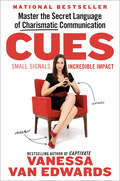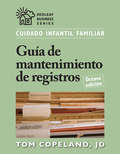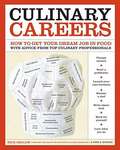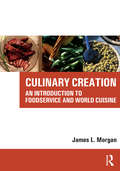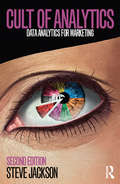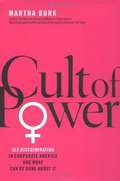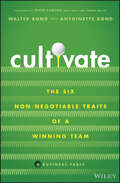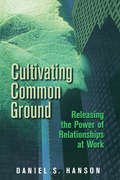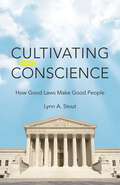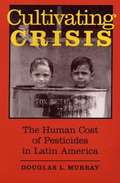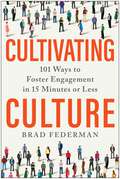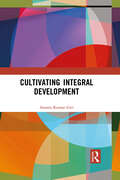- Table View
- List View
Cuenta contigo: No busques fuera, las soluciones están en ti
by Patricia RamírezPatricia Ramírez nos ofrece 20 propuestas para dejar de depender de los demás, tomar las riendas de nuestra propia vida y alcanzar así nuestros objetivos personales, profesionales y deportivos. Porque las soluciones a los propios problemas están mucho más cerca de lo que pensábamos: en nuestro propio interior. «Hay una fuerza motriz más poderosa que el vapor, la electricidad y la energía atómica: la voluntad.»Albert Einstein ¿En qué medida nuestro éxito personal, profesional y deportivo depende de nosotros? ¿Son los demás los que nos boicotean, estresan e impiden que alcancemos nuestros sueños? En Cuenta contigo Patricia Ramírez nos propone empezar a trabajar desde el propio interior para lograr nuestros propósitos. Si para empezar a hacer ejercicio necesitamos la compañía de un amigo, si para ser titular en nuestro equipo solo dependemos de la decisión del entrenador, o si para mejorar nuestro inglés esperamos que sea la empresa la que se encargue de nuestra formación, tal vez nunca logremos nuestros propósitos. ¿Por qué? Porque en estos tres casos, parece que el éxito dependerá de lo que los demás hagan por nosotros. Y esto es cómodo, pero poco eficaz. Patricia Ramírez nos propone que aprendamos a responsabilizarnos de nuestros objetivos, emociones y pensamientos; en definitiva, de las cosas que nos ocurren en la vida. Y nos ofrece herramientas prácticas para ese aprendizaje como la sorprendente terapia del caballo-secretaria o la de Teresa de Calcuta. Reseñas:«Leer a Patricia es aprender continuamente. La persona está antes que el deportista, y la gestión de todo lo emocional y el interior de las personas y deportistas son clave. El libro, tremendamente interesante; y ella, un referente para mí.»Xavier Budó, entrenador de tenis «Transitamos temporalmente portando un equipaje cargado de creencias e ideas no siempre idóneas para afrontar el viaje de la vida. En esta obra, Patricia Ramírez nos da claves para replantear y preguntar adecuadamente si aquello que nos acompaña en nuestro trayecto vital es lo más acertado o no. Obra clara, directa y tremendamente inspiradora.»Andoni Luis Aduriz, chef del restaurante Mugaritz «Patricia transmite fácil lo difícil, aporta soluciones a los problemas, y lo mejor de todo es que lo hace con una naturalidad tan cercana que te engancha desde el primer momento. ¡Sin lugar a dudas se ha convertido en una referente en nuestro deporte!»Alex Corretja, ex tenista «Nadie como Patricia Ramírez para ayudarte a darla mejor versión de ti mismo/a. Con sus "momentos libreta" entrenarás con Patri como si fueras un/a deportista de alta competición... en tu propia vida. Vive el presente (no temerariamente) y haz posible el futuro que quieres.»Juan Carlos Cubeiro, Head of Talent de ManpowerGroupy CEO de Right Management
Cuenta contigo: No busques fuera, las soluciones están en ti
by Patricia RamírezPatricia Ramírez nos ofrece 20 propuestas para dejar de depender de los demás, tomar las riendas de nuestra propia vida y alcanzar así nuestros objetivos personales, profesionales y deportivos. Porque las soluciones a los propios problemas están mucho más cerca de lo que pensábamos: en nuestro propio interior. «Hay una fuerza motriz más poderosa que el vapor, la electricidad y la energía atómica: la voluntad.»Albert Einstein ¿En qué medida nuestro éxito personal, profesional y deportivo depende de nosotros? ¿Son los demás los que nos boicotean, estresan e impiden que alcancemos nuestros sueños? En Cuenta contigo Patricia Ramírez nos propone empezar a trabajar desde el propio interior para lograr nuestros propósitos. Si para empezar a hacer ejercicio necesitamos la compañía de un amigo, si para ser titular en nuestro equipo solo dependemos de la decisión del entrenador, o si para mejorar nuestro inglés esperamos que sea la empresa la que se encargue de nuestra formación, tal vez nunca logremos nuestros propósitos. ¿Por qué? Porque en estos tres casos, parece que el éxito dependerá de lo que los demás hagan por nosotros. Y esto es cómodo, pero poco eficaz. Patricia Ramírez nos propone que aprendamos a responsabilizarnos de nuestros objetivos, emociones y pensamientos; en definitiva, de las cosas que nos ocurren en la vida. Y nos ofrece herramientas prácticas para ese aprendizaje como la sorprendente terapia del caballo-secretaria o la de Teresa de Calcuta. Reseñas: «Leer a Patricia es aprender continuamente. La persona está antes que el deportista, y la gestión de todo lo emocional y el interior de las personas y deportistas son clave. El libro, tremendamente interesante; y ella, un referente para mí.»Xavier Budó, entrenador de tenis «Transitamos temporalmente portando un equipaje cargado de creencias e ideas no siempre idóneas para afrontar el viaje de la vida. En esta obra, Patricia Ramírez nos da claves para replantear y preguntar adecuadamente si aquello que nos acompaña en nuestro trayecto vital es lo más acertado o no. Obra clara, directa y tremendamente inspiradora.»Andoni Luis Aduriz, chef del restaurante Mugaritz «Patricia transmite fácil lo difícil, aporta soluciones a los problemas, y lo mejor de todo es que lo hace con una naturalidad tan cercana que te engancha desde el primer momento. ¡Sin lugar a dudas se ha convertido en una referente en nuestro deporte!»Alex Corretja, ex tenista «Nadie como Patricia Ramírez para ayudarte a darla mejor versión de ti mismo/a. Con sus "momentos libreta" entrenarás con Patri como si fueras un/a deportista de alta competición... en tu propia vida. Vive el presente (no temerariamente) y haz posible el futuro que quieres.»Juan Carlos Cubeiro, Head of Talent de ManpowerGroup y CEO de Right Management
Cues: Master the Secret Language of Charismatic Communication
by Vanessa Van EdwardsFor anyone who wants to be heard at work, earn that overdue promotion, or win more clients, deals, and projects, the bestselling author of Captivate, Vanessa Van Edwards, shares her advanced guide to improving professional relationships through the power of cues.What makes someone charismatic? Why do some captivate a room, while others have trouble managing a small meeting? What makes some ideas spread, while other good ones fall by the wayside? If you have ever been interrupted in meetings, overlooked for career opportunities or had your ideas ignored, your cues may be the problem – and the solution. Cues – the tiny signals we send to others 24/7 through our body language, facial expressions, word choice, and vocal inflection – have a massive impact on how we, and our ideas, come across. Our cues can either enhance our message or undermine it. In this entertaining and accessible guide to the hidden language of cues, Vanessa Van Edwards teaches you how to convey power, trust, leadership, likeability, and charisma in every interaction. You&’ll learn: • Which body language cues assert, &“I&’m a leader, and here&’s why you should join me.&” • Which vocal cues make you sound more confident • Which verbal cues to use in your résumé, branding, and emails to increase trust (and generate excitement about interacting with you.) • Which visual cues you are sending in your profile pictures, clothing, and professional brand. Whether you're pitching an investment, negotiating a job offer, or having a tough conversation with a colleague, cues can help you improve your relationships, express empathy, and create meaningful connections with lasting impact. This is an indispensable guide for entrepreneurs, team leaders, young professionals, and anyone who wants to be more influential.
Cuidado infantil familiar Guía de mantenimiento de registros, Octava edición
by Tom CopelandThis book covers everything home-based family child care providers need to keep accurate business records-from tracking income and expenses to working with a tax professional.It includes:More than 1,000 allowable deductionsClarifications on how to calculate the Time-Space percentageDescriptions of new tax laws and relevant court casesAn in-depth discussion on how to keep business records organized and current
Culinarian Cookware: Pondering Price Promotion
by John A. Quelch Heather BeckhamIn November of 2006, senior executives at Culinarian Cookware were debating the merits of price promotions for the company's premium cookware products. The VP of Marketing, Donald Janus, and Senior Sales Manager, Victoria Brown, had different views. Janus felt price promotions were unnecessary, potentially damaging to the brand image, and possibly encouraged retailer hoarding; Brown believed the promotions strengthened trade support, improved brand awareness, and stimulated sales from both new and existing customers. The issue was complicated by a consultant's study of the firm's 2004 price promotions which concluded that these promotions had a negative impact on profits. Janus trusted the results, but Brown, believing the study assumptions were flawed and required further analysis, suspected the promotions had actually produced positive results. The pressing decision is whether to run a price promotion in 2007 and, if so, to determine what merchandise to promote and on what terms. The broader issue is what strategy Culinarian should pursue to achieve sales growth goals, and what role, if any, price promotion should play.
Culinary Careers For Dummies
by Michele Thomas Annette Tomei Tracey Vasil BiscontiniThe fast and easy way to find your place in the culinary field Ever dream of exploring an exciting career in culinary arts or cooking but don't know where to begin? Culinary Careers For Dummies is the perfect book for anyone who dreams of getting into the culinary profession. Whether you're a student, an up-and-coming chef looking for direction, or are simply interested in reinventing yourself and trying your hand at a new career, Culinary Careers For Dummies provides the essential information every culinary novice needs to enter and excel in the food service industry. Packed with advice on selecting a culinary school and tips for using your degree to land your dream job, Culinary Careers For Dummies offers up-to-the-minute information on: culinary training, degrees, and certificates; the numerous career options available (chef, chef's assistant, pastry chef, food stylist, caterer, line cook, restaurant publicist/general manager, Sommelier, menu creator, food writer, consultant/investor, etc. ) and the paths to get there; basic culinary concepts and methods; advice on finding a niche in the culinary world; culinary core competencies; food safety and proper food handling; real-life descriptions of what to expect on the job; and how to land a great culinary job. Expert guidance on cooking up your career plan to enter the food service industry Tips and advice on what to study to get you where you're headed Packed with information on the many career options in the culinary field Culinary Careers For Dummies is a one-stop reference for anyone who is interested in finding a career in this growing and lucrative field.
Culinary Careers: How to Get Your Dream Job in Food with Advice from Top Culinary Professionals
by Rick Smilow Anne E. Mcbride<p>Turn a passion for food into the job of a lifetime with the insider advice in <i>Culinary Careers</i>. <p>Working in food can mean cooking on the line in a restaurant, of course, but there are so many more career paths available. No one knows this better than Rick Smilow—president of the Institute of Culinary Education (ICE), the award-winning culinary school in New York City—who has seen ICE graduates go on to prime jobs both in and out of professional kitchens. Tapping into that vast alumni network and beyond, <i>Culinary Careers</i> is the only career book to offer candid portraits of dozens and dozens of coveted jobs at all levels to help you find your dream job. <p>Instead of giving glossed-over, general descriptions of various jobs, <i>Culinary Careers</i> features exclusive interviews with both food-world luminaries and those on their way up, to help you discover what a day in the life is really like in your desired field. <p> <li>Get the ultimate in advice from those at the very pinnacle of the industry, including Lidia Bastianich, Thomas Keller, and Ruth Reichl. <li>Figure out whether you need to go to cooking school or not in order to land the job you want. <li>Read about the inspiring—and sometimes unconventional—paths individuals took to reach their current positions. <li>Find out what employers look for, and how you can put your best foot forward in interviews. <li>Learn what a food stylist’s day on the set of a major motion picture is like, how a top New York City restaurant publicity firm got off the ground, what to look for in a yacht crew before jumping on board as the chef, and so much more.</li> <p> <p>With information on educational programs and a bird’s-eye view of the industry, <i>Culinary Careers</i> is a must-have resource for anyone looking to break into the food world, whether you’re a first-time job seeker or a career changer looking for your next step.</p>
Culinary Creation
by James MorganThe book seeks not to present a detailed history and discussion, but instead is intended to provide the student with an appreciation of the idea that all cuisines of the world have something unique to offer to a menu. The author strongly believes that foods of other nations (and even other areas of the United States) are too often given short shrift by culture-bound students and chefs, and that every attempt should be made to open their minds to the unlimited possibilities available. The word “foodism” is introduced to refer to biases against foods outside your culture.
Culinary Essentials
by Johnson Wales UniversityOpen foodservice career pathways with this outstanding new program! Packed with great charts and extraordinary full-color illustrations, this text provides a current and practical view of the culinary workplace.
Culinary Man and the Kitchen Brigade: Normative Subjectivity in Western Fine Dining Traditions (Routledge Food Studies)
by Jordan FallonCulinary Man and the Kitchen Brigade offers an exploration of the field of normative subjectivity circulated within western fine dining traditions, presenting a theoretical analysis of the governing relationship between the chef, who embodies the Culinary Man, and the fine dining brigade.The book offers a unique treatment of western haute cuisine’s interlocking regime of labor and aesthetics and theorizes the underexplored kitchen brigade as a model of disciplinary formation. It deploys a heterogeneous set of disciplinary discourses and practices which have the effect of consolidating monopolies on epistemic authority and governance. Each position within the brigade’s hierarchy is subject to distinct, though related, disciplinary practices. Thus, chapters identify the specific practices pertinent to each brigade subject, while also illuminating how they fit together as a coherent hegemonic project. The application of Wynterian and Foucauldian insight to the fine dining brigade offers a political theory of culinary work which departs from other food studies texts. Notably, this work offers an in-depth treatment of the brigade’s colonial dimensions which resonate with emerging critiques, scholarly and general, of the race and gender politics of restaurant labor. The concluding chapters seek to identify where extant modes of resistance or alternative forms of culinary organization may hold the potential to move beyond the hegemonic overrepresentation of Culinary Man.This book will be of great interest to students and scholars from across the social sciences and humanities interested in critical food studies, political and cultural theory, and popular culinary culture.
Culinary Taste: Consumer Behaviour In The International Restaurant Sector (Hospitality, Leisure And Tourism Ser.)
by Prue Leith Donald SloanCulinary Taste: Consumer Behaviour in the International Restaurant Sector looks at the factors that influence our culinary tastes and dining behaviour, illustrating how they can translate into successful business in industry.With a foreword from Prue Leith, restaurateur, author, teacher, and prolific cookery writer and novelist, and a list of well-known and respected international contributors from the UK, France, Australia and Hong Kong, this text discusses the issues involved from a multitude of angles.
Culinary Tourism
by Lucy M. LongCulinary Tourism is the first book to consider food as both a destination and a means for tourism. The book's contributors examine the many intersections of food, culture and tourism in public and commercial contexts, in private and domestic settings, and around the world. The contributors argue that the sensory experience of eating provides people with a unique means of communication. Editor Lucy Long contends that although the interest in experiencing ""otherness"" is strong within American society, total immersion into the unfamiliar is not always welcome. Thus spicy flavors of Latin Aermcia and the exotic ingredients of Asia have been mainstreamed for everyday consumption. Culinary Tourism explains how and why interest in foreign food is expanding tastes and leading to commercial profit in America, but the book also show how tourism combines personal experiences with cultural and social attitudes toward food and the circumstances for adventurous eating.
Cult of Analytics: Data analytics for marketing (Emarketing Essentials Ser.)
by Steve JacksonCult of Analytics enables professionals to build an analytics driven culture into their business or organization. Marketers will learn how to turn tried and tested tactics into an actionable plan to change their culture to one that uses web analytics on a day to day basis.Through use of the fictitious ACME PLC case, Steve Jackson provides working examples based on real life situations from the various companies he has worked with, such as Nokia, KONE, Rovio, Amazon, Expert, IKEA, Vodafone, and EMC. These examples will give the reader practical techniques for their own business regardless of size or situation making Cult of Analytics a must have for any would-be digital marketer. This new edition has been thoroughly updated, now including examples out of how to get the best from Google analytics, as well as ways to use social media data, big data, tag management and advanced persona segmentation to drive real value in your organisation. It's also been expanded to include exercises and new cases for students and tutors using the book as a text.
Cult of Power: Sex Discrimination in Corporate America and What Can Be Done About It
by Martha BurkIt all started routinely enough--with a simple three-paragraph letter, addressing a little-noticed issue in the eternal battle for gender equity. But it exploded into a cause celebre that laid bare the ways in which, and the reasons why, women are still systematically barred from the highest echelons of power--in government, social and religious organizations, and most importantly, in corporate America.
Cult of the Luxury Brand
by Paul Husband Radha ChadhaWith Hong Kong boasting more Gucci and Hermäs stores than New York or Paris, and 94% of young women in Tokyo owners of a Louis Vuitton bag, the Asian consumer is a new target for brand-creation. TheCult of the Luxury Brand illuminates the mysterious inner workings of Asia's love affair with luxury for business professionals and intrigued consumers alike.
Cultivate: The Six Non-Negotiable Traits of a Winning Team
by Walter Bond Antoinette BondRecruit, develop, and retain a high-performing team Cultivate: The Six Non-Negotiable Traits of a Winning Team is a robust and empowering narrative about three corporate team leaders discovering how to build a high-performing team. Over the course of the story, you’ll follow these frustrated leaders as they take an introspective look into their own flaws, strengths, fears, habits, and shortcomings and learn firsthand how they impact their teams’ cultures. The authors demonstrate how leaders build the cultures they work in and explain why it’s up to them to manage and improve it. The book is packed with tried-and-true teamwork fundamentals that are simple to understand and apply. Readers will also find: Explanations of why companies are struggling to recruit, develop, and retain strong teams Practical and applicable tips for employee and team member retention Explorations of the six traits of high-performing teams that are the signature of all elite business unitsA can’t-miss journey through the fundamentals of recruiting, building, and maintaining a high-performing team in your own organization, Cultivate will earn a place in the libraries of executives, managers, and other business leaders struggling to adapt to the human resources and retention challenges posed by the new economy. In business, Winning, Losing, or Championship organizations are totally dependent on a leader’s ability to CULTIVATE!
Cultivating Capabilities to Innovate: Booz.Allen & Hamilton
by Clayton M. Christensen Bret BairdDescribes the efforts of the president of Booz.Allen, a major consulting firm, to understand and improve the way that products, services, and processes are developed and deployed throughout the firm. Proactive management of these processes proves very difficult because of the firm's decentralized decision structure and the firm's cultural predisposition to listen to its existing customers.
Cultivating Common Ground
by Daniel HansonCaring is a nitty-gritty process. Cultivating Common Ground teaches us how to care at work with real life experiences, rather than through conceptual thinking alone. Caring relationships to our work and each other give meaning to our work and provide a powerful source of energy for our organizations. Therefore, we must release relationships from their hiding place in the informal structure of the organization. The way to do that is to work together, to cultivate common ground, in order to make a conscious commitment to hold a life and a task in common. As old structures crumble, we have the opportunity to build caring communities at work. This book explains what went wrong in the first place, names our fears, and provides real-life examples of how to release the power of relationships in the workplace. Daniel S. Hanson is President of the Fluid Dairy Division of Land O'Lakes, Inc., an instructor at Augsburg College in Minneapolis, and a speaker and author on the subject of organizational change and personal empowerment. Hanson draws on his 30 years experience as a corporate executive for four Fortune 500 companies, his extensive research, and his own life-changing experience to offer practical, hands-on presentations and trainings. He is also the author of A Place To Shine: Emerging From the Shadows at Work, Butterworth-Heinemann, 1996."This is a compassionate and powerful call for caring in the workplace. Dan Hanson is right on the mark when he suggests that we need to take courageous steps toward a new, caring workplace. He is one of the best teachers of building community at work you'll ever meet."--Richard J. Leider, founding partner, The Inventure Group, author, "Repacking Your Bags" and "The Power of Purpose" "Dan Hanson delves broadly and deeply into the nature of relationships in the workplace. He lays before us the common ground that nourishes results as well as meaning and satisfaction for the human heart and soul. Hanson provides the tools and knowledge we need to cultivate this garden. We are called to fertilize the soil with our own courage."--Margaret A. Lulic, author, "Who We Could Be at Work"
Cultivating Communities of Practice
by Etienne Wenger Richard A. Mcdermott William SnyderToday's economy is fueled by knowledge. Every leader knows this to be true, yet few have systematic methods for converting organizational knowledge into economic value. This book argues that communities of practice--groups of individuals formed around common interests and expertise--provide the ideal vehicle for driving knowledge-management strategies and building lasting competitive advantage. Written by leading experts in the field, Cultivating Communities of Practice is the first book to outline models and methods for systematically developing these essential groups. Through compelling research and company examples, including DaimlerChrysler, McKinsey & Company, Shell, and the World Bank, authors Etienne Wenger, Richard McDermott, and William M. Snyder show how world-class organizations have leveraged communities of practice to drive strategy, generate new business opportunities, solve problems, transfer best practices, develop employees' professional skills, and recruit and retain top talent. Underscoring the new central role communities of practice are playing in today's knowledge economy, Cultivating Communities of Practice is the definitive guide to fostering, designing, and developing these powerful groups within and across organizations.
Cultivating Communities of Practice: A Guide to Managing Knowledge
by Etienne Wenger Richard A. Mcdermott William SnyderIn order to find out how to make the best use of the knowledge that a company's employees possess, the authoring consultants lift models from Xerox, Daimler Chrysler and the World Bank to show how to tap into the wisdom within.
Cultivating Compliance for Strategic Strength: Mastering the Legal Aspects of Business
by Robert J. Dolan Constance E. BagleyCompliance with the law is just the baseline for winning legally in business. This chapter shows how managers can practice what the author calls "strategic compliance management," which goes beyond mere compliance with the law to embrace organizational integrity and to seek out and exploit business opportunities provided by regulation and deregulation.
Cultivating Conscience: How Good Laws Make Good People
by Lynn StoutHow the science of unselfish behavior can promote law, order, and prosperityContemporary law and public policy often treat human beings as selfish creatures who respond only to punishments and rewards. Yet every day we behave unselfishly—few of us mug the elderly or steal the paper from our neighbor's yard, and many of us go out of our way to help strangers. We nevertheless overlook our own good behavior and fixate on the bad things people do and how we can stop them. In this pathbreaking book, acclaimed law and economics scholar Lynn Stout argues that this focus neglects the crucial role our better impulses could play in society. Rather than lean on the power of greed to shape laws and human behavior, Stout contends that we should rely on the force of conscience.Stout makes the compelling case that conscience is neither a rare nor quirky phenomenon, but a vital force woven into our daily lives. Drawing from social psychology, behavioral economics, and evolutionary biology, Stout demonstrates how social cues—instructions from authorities, ideas about others' selfishness and unselfishness, and beliefs about benefits to others—have a powerful role in triggering unselfish behavior. Stout illustrates how our legal system can use these social cues to craft better laws that encourage more unselfish, ethical behavior in many realms, including politics and business. Stout also shows how our current emphasis on self-interest and incentives may have contributed to the catastrophic political missteps and financial scandals of recent memory by encouraging corrupt and selfish actions, and undermining society's collective moral compass.This book proves that if we care about effective laws and civilized society, the powers of conscience are simply too important for us to ignore.
Cultivating Crisis: The Human Cost of Pesticides in Latin America
by Murray Douglas L.In this study, Douglas Murray draws on ten years of field research to tell the stories of international development strategies, pesticide problems, and agrarian change in Latin America. Interwoven with his considerations of economic and geopolitical dimensions are the human consequences for individual farmers and rural communities.
Cultivating Culture: 101 Ways to Foster Engagement in 15 Minutes or Less
by Brad FedermanAS SEEN IN HR PROFESSIONALS MAGAZINE Perhaps your company culture is immortalized in a mission statement on your website or framed on your office walls, but how often are you actively cultivating those values? Culture cannot be a set-it-and-forget-it aspect of your business. Weaving culture-building into your daily and weekly activities strengthens the engagement of your people and reinforces the key principles of your desired culture, making it a reality. In Cultivating Culture, author, speaker, and leadership coach Brad Federman provides actionable tools for immediately promoting better teamwork, creating two-way conversations with your people, and gaining better feedback about how things are really going. With the belief that we are what we talk about, Federman offers more than 100 ways to engage your team in conversations that matter. Make your meetings about more than tasks, deadlines, and problems, and instead utilize Cultivating Culture&’s pre-meeting notes and activities to grow a deeper understanding of the work you&’re doing and why. Activities are divided into eight key focus areas: Leadership Communication Talent development Inclusion Team harmony Solution seeking Safety Serving your customers Regular attention to these principles will not only sustain your culture and amplify the presence of your values at work, but result in exponential growth in all of your endeavors. Cultivating Culture is your practical, accessible guide to becoming the most effective leader you can, 15 purposeful minutes at a time.
Cultivating Integral Development
by Ananta Kumar GiriThis book cultivates visions and practices of integral development of the self, society, and the world. It builds upon deconstructions of development discourse and practice and strives to reconstruct and reconstitutes it as integral development. It addresses entrenched dualisms in development studies and practices such as between the self and the other, the providers of development and its recipients, materialism, and spirituality, and cultivates pathways of integral development. The book explores the many challenges facing development studies and practice such as poverty, creativity, political economy, moral economy, leadership, sustainable development, and evolutionary flourishing. It also opens the discourse and practice of development to cross-cultural dialogues by undertaking discussions between Euro-centric approaches to development and other visions and practices of development such as Purusartha, Swadhyaya, Sarvodaya, integral yoga, and Lokasasamgraha from Indic traditions. Drawing on multiple cultural and philosophical resources and traditions, Cultivating Integral Development is a pioneering work and will be of great interest to scholars, researchers, and actors of development studies, political science, and philosophy as well as concerned human beings around the world.

